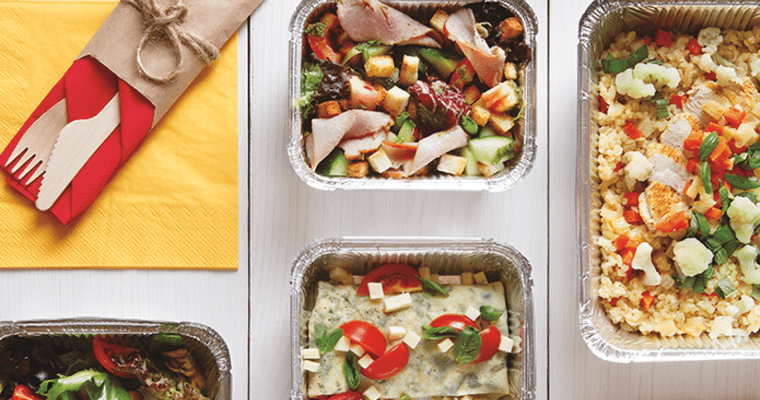Almost from the moment of admission, people are eager to leave a hospital or healthcare setting. It’s natural to want a return to life as usual. Health providers want the same thing, so a thorough discharge plan is instrumental to a person’s transition.
A care transfer program with an inadequate food and nutrition component can complicate a person’s recovery. This is a big challenge for frail elderly people and those with chronic illness who being discharged to return home or to another independent location. Poor nutrition at a time of healing can lead to a decline in weight and health that causes delayed healing and even admission to a hospital.
Sometimes, improving dietary intake is as simple as getting meals in the hands of those transitioning out of healthcare. Centers for Medicare and Medicaid (CMS) is placing more emphasis on services to enhance care when patients transfer from one care setting to another, or to home. This includes addressing a person’s ongoing needs, such as help with meals or grocery shopping. Care coordination can play a big role. Here are three ways to meet their needs, enhance recovery and prevent readmissions.
1. Evaluate each individual
Discharge planning is a process, but one size doesn’t fit all. A dietitian or other food and nutrition services staff member can help a discharge planner by making appropriate referrals. As nutrition experts, they can identify people at risk for nutrition problems or those whose status has recently changed and may require more care and attention.
They also can communicate nutrition care needs to those who will help the person being discharged, regardless of whether that person is going home or to another care setting, such as rehab or long-term care.
2. Encourage independence
A person’s nutrition needs don’t stop once discharged. In fact, adequate food intake becomes even more critical in promoting continued recovery and independence to whatever extent possible. Involving a food and nutrition services member on your discharge-planning team can help determine:
- Can the person shop and/or prepare meals?
- If not, does the person have support at home?
- Does the person have reliable transportation or meal delivery?
- Does the person have special nutrition needs, such as a texture-modified diet, fluid restrictions or allergies?
At Oklahoma Methodist Manor in Tulsa, Oklahoma, Director of Nutrition Martha Blevins, MS, RDN/LD, says it’s important for food and nutrition services to be involved from the beginning. It is especially important to engage fully at least up to two weeks prior to discharge to allow time for education, choosing a home health agency, ordering equipment, therapy planning and making a home visit to make sure the person being discharged can continue recovery.
She encourages special attention to feeding and diet, addressing issues such as tube feeding, texture-modified diets, malnutrition education and referrals. Her recommendations include:
Texture-modified diets. People need resources on where to buy ready-to-use puréed food and pre-thickened liquids, as well as instruction and recipes on puréeing food at home.
Malnutrition education. Educate clients on the connection between good nutrition and healing. Discuss ways to increase caloric intake at home with foods they enjoy, and also explain about nutrition supplement use, if appropriate.
Help with referrals. Make sure clients in need and their loved ones have referrals for home- and community-based meal services. Also, assure they have a way to connect with nutrition-related specialists, such as a certified diabetes educator or an endocrinologist. This often involves providing information to help them choose someone in their health system or getting their primary doctor to write a referral.
Tube feeding. Use a DVD on tube feeding at home or hands-on instruction with administering tube feeding and medication to teach people or home caregivers what they need to know.
3. Consider a home meal program
Another way to encourage proper eating and independence after discharge is to establish a home meal program. Lee Health System in Fort Myers, Florida, created a Flavor Harvest at Home program to deliver food to people who have been discharged.
People who are part of the program must be age 55-plus, with some form of acute or chronic disease that causes them to be inadequately nourished. They must also meet two of the six clinical criteria for malnourishment identified by the Academy of Nutrition and Dietetics. This is where involving a dietitian in discharge planning is critical in assessing the need.
People recommended for the program get food deliveries once a week for four weeks. It includes a combination of fresh, frozen and shelf-stable meals or components. A driver not only brings the food, but makes sure it is properly stored in the home. This outreach continues a social connection with people after discharge and, at the same time, encourages recovery by facilitating eating, healing and independence.
There are many routes to adding a home meal program. It can be as simple as partnering with community-based services such as Meals on Wheels, sending convenience meals home with clients, having meal options available for pickup, or all the way to a full service program such as Lee Health’s. Either way, enhancing nutrition services as part of your care transition program can go a long way toward improving health outcomes.
Making a successful transition
These three areas promote a successful move from one level of care to another. Together, they work to evaluate a person’s needs, promote the planning, education, referrals and arrangements that promote nutrition and feeding. Effective discharge planning is not only best for the individual, but because it reduces readmissions and associated costs, it’s a positive for the caregiver.




























